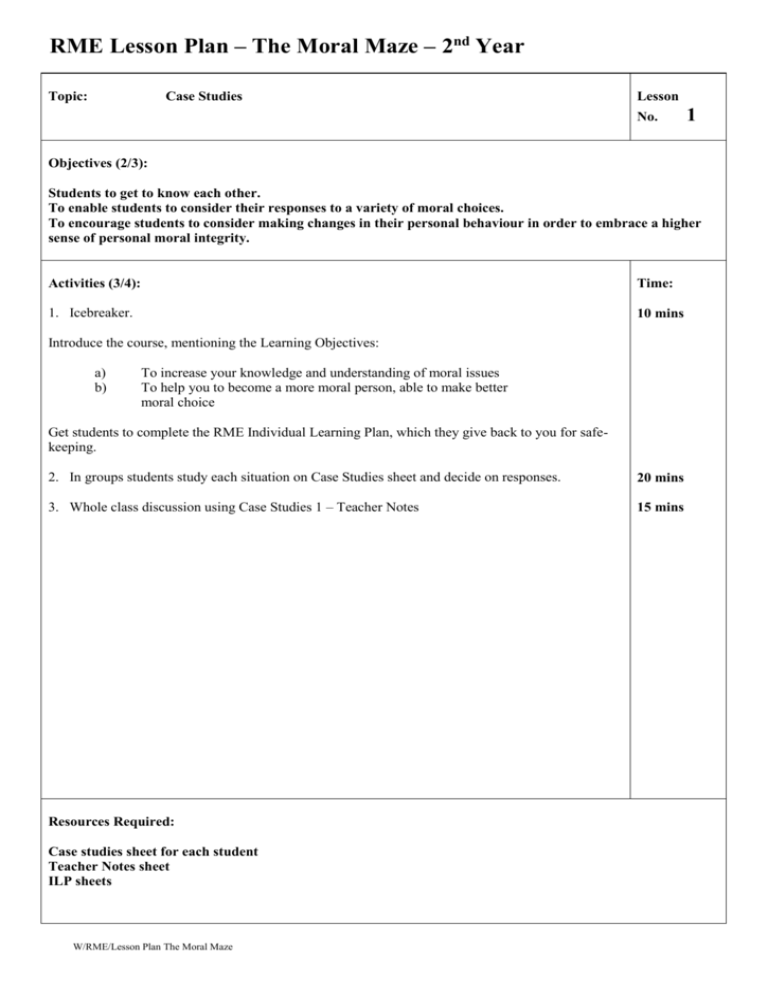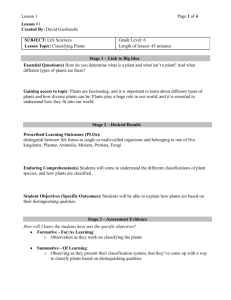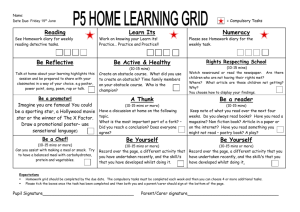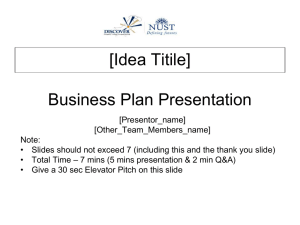RME Lesson Plan
advertisement

RME Lesson Plan – The Moral Maze – 2nd Year Topic: Case Studies Lesson No. 1 Objectives (2/3): Students to get to know each other. To enable students to consider their responses to a variety of moral choices. To encourage students to consider making changes in their personal behaviour in order to embrace a higher sense of personal moral integrity. Activities (3/4): Time: 1. Icebreaker. 10 mins Introduce the course, mentioning the Learning Objectives: a) b) To increase your knowledge and understanding of moral issues To help you to become a more moral person, able to make better moral choice Get students to complete the RME Individual Learning Plan, which they give back to you for safekeeping. 2. In groups students study each situation on Case Studies sheet and decide on responses. 20 mins 3. Whole class discussion using Case Studies 1 – Teacher Notes 15 mins Resources Required: Case studies sheet for each student Teacher Notes sheet ILP sheets W/RME/Lesson Plan The Moral Maze RME Lesson Plan – The Moral Maze – 2nd Year Topic: What About You? Lesson No. Objectives (2/3): 2 To consider what sin/wrongdoing is? To get students to explore their own personal morality and what they believe to be right/wrong To place morality in a spiritual context Activities (3 / 4): Time: 1. What is sin/wrongdoing? In groups of 3 try to get some kind of definition (put on board an agreed definition). 5 mins 2. Brainstorm the most common things people do which are wrong – write a list on the board. Are some things worse than others? Why? Put the sins into three groups: 10 mins How we treat ourselves (e.g., drug taking, excessive drinking etc.) How we treat others (e.g., putting others down, stealing etc.) How we treat God (e.g., ignoring God, denying my faith to others) Discuss the idea of doing wrong by not doing anything, or not doing enough, e.g., do we do enough to help the poor? 3. Take the Test – Are you a Moral Person? 15 mins 4. At the end of the Test get students in small groups to decide whether they think they are a moral person or not, and why? 10 mins 5. Closing Reflection Issue students with a small piece of paper and ask them to write on it something they would like to be forgiven (remind them of the three possible groups of sins in point 2). Tell them they won’t have to read the sin out! Remember to do one yourself. If you have a candle light this (play music if available) and explain how God is a God of forgiveness and love who wants all His children to be reconciled with Him. 5 mins Prayer: Almighty God, we are sorry for things we have done wrong – please forgive us. We thank you for your forgiveness and healing power. Please give us the love and the grace to be strong in the future, so that we might keep away from anything that is wrong, and do our best to help create a better world for all. Ask students to tear up the sheets into tiny pieces and collect in a small bowl. Demonstrate by tearing yours up first. End by telling the students that the pieces of paper will be destroyed, and their sins forgiven, by the God who loves them. Resources Required: Are You a Moral Person? W/RME/Lesson Plan The Moral Maze RME Lesson Plan – The Moral Maze – 2nd Year Topic: Are You A Moral Person? Lesson No. Objectives (2/3): 2a To consider what is morality? Consider own actions – how can we be more moral? Activities (3 / 4): Time: 1. Issue morality quiz – is this judgmental – does it measure morality? Is there a moral code? Refer to law 10 mins 2. Write a list of our own moral/immoral actions – how can we improve? 10 mins 3. Show ‘Alive & Kicking’ video – example of being active – morality can be improved by positive 25 mins actions not just ‘trying to be good’ – discussion of outcomes for self and others. What could you do? Resources Required: Video Morality quiz W/RME/Lesson Plan The Moral Maze RME Lesson Plan – The Moral Maze – 2nd Year Topic: How Do You Decide What Is Right & Wrong? What makes for a good life? Lesson No. 3 Objectives (2/3): To consider where we learn morality and how we develop our own morality Know meaning of deontology and consequentialism and why morality is sometimes a difficult concept Activities (3 / 4): Time: 1. Brainstorm – small groups – How do you decide what’s right/wrong? Group feedback (draw out socialisation, law, how we feel) 5 mins 2. Students think of examples of things they have changed their view on – why? How did this happen? How did they decide? 10 mins 3. Give out ‘Are Some Things Always Wrong’ Worksheet. Explore differences between deontology and consequentialism 5 mins 10 mins 4. Complete worksheet 5. Group discussion. Get students to discuss what they have written for point 8 5 mins 6. Closing exercise. In groups students draw up a list of statements 10 mins It is always right to … It is always wrong to … Resources Required: Worksheet on moral maze Paper W/RME/Lesson Plan The Moral Maze RME Lesson Plan – The Moral Maze – 2nd Year Topic: Why Is It Important To Have High Ethical Standards; What Happens When Lesson You Don’t; Karma No. 4 Objectives (2/3): Explore meaning of Karma To discuss consequences on society and personal fulfilment of living an ethical/unethical life To explore why high ethical standards are necessary Activities (3 / 4): Time: 1. Video clip of ‘My Name is Earl’ and discussion of Karma 5 – 10 mins 2. Revisit moral dilemmas – in groups (3-4) consider a scenario where one does not do the right thing – create a role play or summary of this. Present to class. 15 mins 3. Group (whole) discussion of what are high ethical standards – create list on board. Consider whether bar should be set high – does anyone achieve it? Do we still need it? Make point that we are striving towards living an ethical life 10 mins 4. Example of someone ‘straying from path’, e.g., Mary Magdelene, Prodigal Son and discussion of what we can learn from this. How does the ‘high bar’ help? 10 mins Resources Required: Video Clip Sugar Paper Example (story) W/RME/Lesson Plan The Moral Maze RME Lesson Plan – The Moral Maze – 2nd Year Topic: Top Tips for Living an Ethical Life Spiritual Codes of Conduct Lesson No. 5 Objectives (2/3): Students to explore ethical qualities and evaluate them Students to relate these to personal experiences Set targets for personal growth Activities (3 / 4): Time: 1. Present case study examples of Franz Jagerstatter and Sophie Scholl (see sheets) 10 mins 2. Students brainstorm further examples of their personal ethical role models. Feedback 5 mins 3. Diamond 9 on the qualities needed (see sheet). Plenary 20 mins 4. Each student to write one statement about one of their strengths or something about themselves they wish to improve. Collect in hat, distribute and read. 10 mins 5. Prayer 5 mins Resources Required: Case Studies Diamond 9 and Hat W/RME/Lesson Plan The Moral Maze RME Lesson Plan – Celebrating Diversity – 1st Year Topic: Personal Belief and Ethical Dilemmas Lesson No. Objective: To explore how religious beliefs/spiritual values influence moral decisions Activities: Time: GROUP DISCUSSION: Small multi-faith groups of students discuss the moral dilemmas on the handout. They give their personal response and also include any insights from their religious teaching and traditions. 20 mins FEEDBACK TO CLASS: Groups feed back to the class, giving a detailed account of their thinking, especially their disagreements. 15 mins TEACHER SUMMARY: Teacher draws out principles and moral complexities if students do not (Eg the sanctity of life, utilitarianism - what does this really mean for dilemma 1?) 5 mins NB. The discussion and feedback can be split up if desirable: ie. groups could discuss just dilemmas 1, 2, 3 then feed back etc. Resources required: Moral Dilemma 1 sheets W/RME/Lesson Plan The Moral Maze 6 RME Lesson Plan – The Moral Maze – 2nd Year Topic: Moral Dilemmas 2 Lesson No. Objectives (2/3): 6 To explore in more detail a number of case studies and the principles we use to make a moral decision To understand that moral decisions are sometimes not as black/white as they may at first appear Activities (3 / 4): Time: Get students into groups and either read out or give them copies of Moral Dilemmas 2 Group discussion and plenary If time, get students to discuss their responses to the Valjean Dilemma: 30 mins The Valjean Dilemma In a country in Europe, a poor man named Valjean could find no work, nor could his sister and brother. Without money, he stole food and medicine that they needed. He was captured and sentenced to prison for six years. After a couple of years, he escaped from the prison and went to live in another part of the country under a new name. He saved money and slowly built up a big factory. He gave his workers the highest wages and used most of his profits to build a hospital for people who couldn't afford good medical care. Twenty years had passed when a tailor recognized the factory owner as being Valjean, the escaped convict whom the police had been looking for back in his hometown. Probe Questions: 1. Should the tailor report Valjean to the police? 1a. Why or why not? 2. Does a citizen have a duty or obligation to report an escaped convict? 2a. Why or why not? 3. Suppose Valjean were a close friend of the tailor. Should he then report Valjean? 3a. Why or why not? 4. If Valjean were reported and brought before the judge, should the judge send him back to jail or let him go free? 4a. Why? 5. Thinking in terms of society, should people who break the law be punished? 5a. Why or why not? 5b. How does this apply to what the judge should do? 6. Valjean was doing what his conscience told him to do when he stole the food and medicine. Should a lawbreaker be punished if he is acting out of conscience? 6a. Why or why not? Resources Required: Moral Dilemmas 2 sheet W/RME/Lesson Plan The Moral Maze 15 mins RME Lesson Plan – The Moral Maze – 2nd Year Topic: Objectives (2/3): The Problem of Evil – ‘Why does God allow bad things to happen to good people?’ Lesson No. 7 To explore how events such as the Holocaust can be reconciled with the idea of a God of love To understand a variety of possible explanations for the Problem of Evil Activities (3/4): Time: See The Problem of Evil Teacher’s Notes and Worksheet 45 mins Resources Required: Teachers Notes Powerpoint Problem of Evil Worksheet W/RME/Lesson Plan The Moral Maze RME Lesson Plan – The Moral Maze – 2nd Year Topic: The Strength to be Good Objectives (2/3): To explore where conscience comes from and what it means to have a conscience Activities (3/4): 1. Brainstorm what images/words are associated with Heaven and Hell – put key points suggested by students on board. Present images. 2. Introduce question – does conscience come from external or internal motivation? 3. Conscience powerpoint – use for discussion and brainstorm 4. Closing prayer Resources Required: The powerpoints on Wdrive W/RME/Lesson Plan The Moral Maze Lesson No. 7 Time: RME Lesson Plan – The Moral Maze – 2nd Year Topic: Issues of Life: Animal Rights in relation to medical trials Lesson No. 8 Objectives (2/3): Explore the moral issue of animal rights Outline the arguments if favour and against of using animals in medical trials Reach a reasoned judgement on the issue of animal rights Activities (3/4): Time: Introduction of topic and reasons for studying it. Students to share any view they may currently have. 5 mins Fact or Fiction? Students to complete a true or false worksheet on the statistics, legalities and purposes of animal testing. Feedback and brief discussion on answers. 10 mins In groups, students to come up with the arguments in favour and those against animal testing. 15 mins 5 mins Feedback to the board and teacher to develop with prepared OHT/Power-point. Time permitting, a brief synopsis of current developments. Plenary – What have you learnt and have you changed you view – why? 5 mins 5 mins Resources Required: Fact or Fiction sheets, board, board pens, A3 Paper, Felt tip pens, computer and projector W/RME/Lesson Plan The Moral Maze RME Lesson Plan – The Moral Maze – 2nd Year Topic: Why Do People Do Bad Things/Commit Crime? Do Bad People Go To Hell, Lesson and Good People To Heaven? No. 9 Objectives (2/3): Explore reasons why crimes are committed. Consider and evaluate doctrinal and personal responses to perpetrators of crime Activities (3/4): Time: 1. Presentation and discussion of case studies including Bowling for Columbine and John Pridmore (Fiona’s handout). Focus on the reasons behind the crime. 20 mins 2. Examine views of Heaven and Hell from powerpoint – include different religions’ views, literary presentations. Class discussion looking at responses to these. Include questions such as: 15 mins What are Heaven and Hell like? Is there anybody in Hell? What do you have to do to get there? Discuss concept of an all-loving, forgiving God and the idea of eternal damnation. Is there Hell on earth? (Satre said ‘Hell is other people!’). Could explore idea of free will – to what extent can people be held personally responsible for the sin/crime they commit. How far is society to blame? If time explore the idea of re-incarnation. 3. Pairs to compose a prayer, focussing on forgiveness and understanding – perhaps based on the case studies Resources Required: Video of Bowling for Columbine John Pridmore handout Heaven & Hell powerpoint presentation W/RME/Lesson Plan The Moral Maze 10 mins RME Lesson Plan – The Moral Maze – 2nd Year Topic: Living in a Community – Our Responsibilities to Others Lesson No. Objectives (2/3): 10 To explore the meaning of ‘community’ for each individual student To have three new ways that students could positively contribute to community Activities (3 / 4): Time: 1. Starter – students to brainstorm what communities they belong to – family, friends, College, religion etc. – underline what benefits we gain from community (support, advice etc.) 10 mins 2. Use Harrow Gazette – student select an article which they feel best represents ‘a good sense of community’. Students feedback examples 15 mins 3. Draw table on board: What do you get from College community? What can/do you contribute to College community/ Students use this to set themselves targets as to why they currently do, and how they could contribute more 4. Finish with ethical handout – sheet summarising how they feel they should lead a more ethical life (taken from lessons 4 and 5) 10 mins 5. End of lesson 10 mins Reissue the RME ILP sheet. Give students a list of the ten lessons on the course. You could either put on board or screen or have a paper list which you could pass around. You could use the RME Scheme of Work in the RME Learning Strategies Handbook (W/RME/Learning Strategies Handbook). Once you have analysed the results and made any suggested changes to the lessons, pass completed feedback sheets to PWK (and pass lesson plan changes to PH) Resources Required: Copies of Harrow Gazette Ethical handout from lessons 4 and 5 ILP sheets W/RME/Lesson Plan The Moral Maze RME Lesson Plan – The Moral Maze – 2nd Year Topic: Lesson No. Objectives (2/3): Activities (3/4): Resources Required: W/RME/Lesson Plan The Moral Maze Time:








